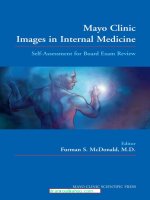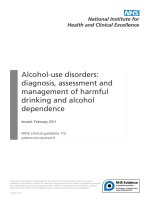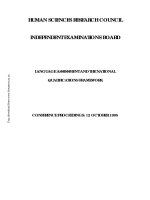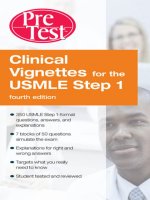Rudolphs pediatrics self assessment and board review, 22e (2014)
Bạn đang xem bản rút gọn của tài liệu. Xem và tải ngay bản đầy đủ của tài liệu tại đây (15.03 MB, 652 trang )
Rudolph’s
PEDIATRICS
22ND EDITION
SELF-ASSESSMENT
AND BOARD REVIEW
NOTICE
Medicine is an ever-changing science. As new research and clinical experience broaden
our knowledge, changes in treatment and drug therapy are required. The authors and
the publisher of this work have checked with sources believed to be reliable in their
efforts to provide information that is complete and generally in accord with the standards accepted at the time of publication. However, in view of the possibility of human
error or changes in medical sciences, neither the authors nor the publisher nor any other
party who has been involved in the preparation or publication of this work warrants
that the information contained herein is in every respect accurate or complete, and they
disclaim all responsibility for any errors or omissions or for the results obtained from
use of the information contained in this work. Readers are encouraged to confirm the
information contained herein with other sources. For example and in particular, readers are advised to check the product information sheet included in the package of each
drug they plan to administer to be certain that the information contained in this work
is accurate and that changes have not been made in the recommended dose or in the
contraindications for administration. This recommendation is of particular importance
in connection with new or infrequently used drugs.
Rudolph’s
PEDIATRICS
22ND EDITION
SELF-ASSESSMENT
AND BOARD REVIEW
Editor
Michael D. Cabana, MD, MPH
Professor of Pediatrics, Epidemiology, and Biostatistics
Chief, Division of General Pediatrics
Department of Pediatrics
University of California, San Francisco
UCSF Benioff Children’s Hospital
Philip R. Lee Institute for Health Policy Studies
San Francisco, California
Consulting Editors
Hilary M. Haftel, MD, MHPE
Professor of Pediatrics
Department of Pediatrics and Communicable Diseases
University of Michigan
Ann Arbor, Michigan
Sunitha V. Kaiser, MD
Assistant Professor of Pediatrics
Department of Pediatrics
University of California, San Francisco
San Francisco, California
Julie Stein O’Brien, MD
Assistant Professor of Pediatrics
Department of Pediatrics
University of California, San Francisco
San Francisco, California
New York Chicago San Francisco Athens London Madrid
Mexico City Milan New Delhi Singapore Sydney Toronto
Copyright © 2014 by McGraw-Hill Education. All rights reserved. Except as permitted under the United States Copyright Act of 1976, no part of this publication may
be reproduced or distributed in any form or by any means, or stored in a database or retrieval system, without the prior written permission of the publisher.
ISBN: 978-0-07-178110-7
MHID: 0-07-178110-2
The material in this eBook also appears in the print version of this title: ISBN: 978-0-07-178109-1,
MHID: 0-07-178109-9.
E-book conversion by codeMantra
Version 1.0
All trademarks are trademarks of their respective owners. Rather than put a trademark symbol after every occurrence of a trademarked name, we use names in an
editorial fashion only, and to the benefit of the trademark owner, with no intention of infringement of the trademark. Where such designations appear in this book, they
have been printed with initial caps.
McGraw-Hill Education eBooks are available at special quantity discounts to use as premiums and sales promotions or for use in corporate training programs. To
contact a representative, please visit the Contact Us page at www.mhprofessional.com.
TERMS OF USE
This is a copyrighted work and McGraw-Hill Education and its licensors reserve all rights in and to the work. Use of this work is subject to these terms. Except
as permitted under the Copyright Act of 1976 and the right to store and retrieve one copy of the work, you may not decompile, disassemble, reverse engineer,
reproduce, modify, create derivative works based upon, transmit, distribute, disseminate, sell, publish or sublicense the work or any part of it without McGraw-Hill
Education’s prior consent. You may use the work for your own noncommercial and personal use; any other use of the work is strictly prohibited. Your right to use the
work may be terminated if you fail to comply with these terms.
THE WORK IS PROVIDED “AS IS.” McGRAW-HILL EDUCATION AND ITS LICENSORS MAKE NO GUARANTEES OR WARRANTIES AS TO THE
ACCURACY, ADEQUACY OR COMPLETENESS OF OR RESULTS TO BE OBTAINED FROM USING THE WORK, INCLUDING ANY INFORMATION
THAT CAN BE ACCESSED THROUGH THE WORK VIA HYPERLINK OR OTHERWISE, AND EXPRESSLY DISCLAIM ANY WARRANTY, EXPRESS
OR IMPLIED, INCLUDING BUT NOT LIMITED TO IMPLIED WARRANTIES OF MERCHANTABILITY OR FITNESS FOR A PARTICULAR PURPOSE.
McGraw-Hill Education and its licensors do not warrant or guarantee that the functions contained in the work will meet your requirements or that its operation will be
uninterrupted or error free. Neither McGraw-Hill Education nor its licensors shall be liable to you or anyone else for any inaccuracy, error or omission, regardless of
cause, in the work or for any damages resulting therefrom. McGraw-Hill Education has no responsibility for the content of any information accessed through the work.
Under no circumstances shall McGraw-Hill Education and/or its licensors be liable for any indirect, incidental, special, punitive, consequential or similar damages
that result from the use of or inability to use the work, even if any of them has been advised of the possibility of such damages. This limitation of liability shall apply
to any claim or cause whatsoever whether such claim or cause arises in contract, tort or otherwise.
To Cewin, Alexandra, Abigail, Annie, and Binko
—MDC
To Mindy, Gene, George, and Georgia
—JSO
To Dan, Lirit, and Shoshana
—HMH
To Rao, Vasu, Scott, and Varun
—SVK
This page intentionally left blank
CONTENTS
16. Musculoskeletal Disorders. . . . . . . . . . . . . . . . . . . . . . 280
Contributors . . . . . . . . . . . . . . . . . . . . . . . . . . . . . . . . . . . . . . . . ix
Hilary M. Haftel
Foreword . . . . . . . . . . . . . . . . . . . . . . . . . . . . . . . . . . . . . . . . . . xv
17. Infectious Disease . . . . . . . . . . . . . . . . . . . . . . . . . . . . . 294
Preface . . . . . . . . . . . . . . . . . . . . . . . . . . . . . . . . . . . . . . . . . . . xvii
Dylan C. Kann, Duha Al-Zubeidi, Erica Pan,
Sunitha V. Kaiser, and Michael D. Cabana
Acknowledgments . . . . . . . . . . . . . . . . . . . . . . . . . . . . . . . . . .xix
18. Disorders of the Skin . . . . . . . . . . . . . . . . . . . . . . . . . . 335
1. Fundamentals of Pediatrics . . . . . . . . . . . . . . . . . . . . . . . 1
Erin F.D. Mathes, Diana Camarillo,
Ann L. Marqueling, Vikash Oza, Julie C. Philp,
Deepti Gupta, and Barrett J. Zlotoff
Laura L. Sisterhen, Natalie J. Burman, and D. Micah Hester
2. Health Promotion and Disease Prevention . . . . . . . . . 17
19. Disorders of the Ear, Nose, and Throat . . . . . . . . . . . 368
Ada M. Fenick
Anna K. Meyer and Kristina W. Rosbe
3. Nutrition. . . . . . . . . . . . . . . . . . . . . . . . . . . . . . . . . . . . . . 43
20. Disorders of the Oral Cavity . . . . . . . . . . . . . . . . . . . . 378
Michael D. Cabana and Cewin Chao
Susan Fisher-Owens and Michael D. Cabana
4. Abuse, Neglect, and Violence . . . . . . . . . . . . . . . . . . . . 55
21. Disorders of the GI Tract . . . . . . . . . . . . . . . . . . . . . . . 386
Christopher C. Stewart
Kristin L. Van Buren, Haley C. Neef, and Eric H. Chiou
5. Newborn. . . . . . . . . . . . . . . . . . . . . . . . . . . . . . . . . . . . . . 65
22. Disorders of the Liver . . . . . . . . . . . . . . . . . . . . . . . . . . 418
W. Christopher Golden, Elizabeth A. Cristofalo,
Bernadette A. Hillman, and Colleen Hughes Driscoll
Sarah Shrager Lusman and Haley C. Neef
23. Disorders of the Blood . . . . . . . . . . . . . . . . . . . . . . . . . 434
6. Principles of Adolescent Care . . . . . . . . . . . . . . . . . . . 103
James Huang and Tannie Huang
Lauren B. Hartman and Sara M. Buckelew
24. Neoplastic Disorders . . . . . . . . . . . . . . . . . . . . . . . . . . 462
7. Development and Behavior . . . . . . . . . . . . . . . . . . . . . 122
Ashley Ward and Robert Goldsby
Martin T. Stein and Julie Stein O’Brien
25. Disorders of the Kidney and Urinary Tract . . . . . . . 480
8. The Acutely Ill Infant and Child. . . . . . . . . . . . . . . . . 143
Kartik Pillutla and Erica Winnicki
Christine S. Cho, Jerusha Pearson-Lev,
and Cornelia Latronica
26. Disorders of the Heart . . . . . . . . . . . . . . . . . . . . . . . . . 493
9. The Chronically Ill Infant and Child . . . . . . . . . . . . . 180
Alaina K. Kipps and Laura A. Robertson
John I. Takayama and Sunitha V. Kaiser
27. Disorders of the Respiratory System . . . . . . . . . . . . . 519
10. Transplantation . . . . . . . . . . . . . . . . . . . . . . . . . . . . . . . 194
Amy G. Filbrun, Danielle M. Goetz, and Nanci Yuan
Marie H. Tanzer and David B. Kershaw
28. Endocrinology . . . . . . . . . . . . . . . . . . . . . . . . . . . . . . . . 547
11. Disorders of Metabolism . . . . . . . . . . . . . . . . . . . . . . . 202
Andrea K. Goldyn and Todd D. Nebesio
Ayesha Ahmad
29. Neurology. . . . . . . . . . . . . . . . . . . . . . . . . . . . . . . . . . . . 571
12. Clinical Genetics and Dysmorphology . . . . . . . . . . . 220
Amy A. Gelfand and Kendall B. Nash
Angela Scheuerle
30. Disorders of the Eyes . . . . . . . . . . . . . . . . . . . . . . . . . . 596
13. Immunologic Disorders . . . . . . . . . . . . . . . . . . . . . . . . 237
Lance M. Siegel and Tina Rutar
Hilary M. Haftel
14. Allergic Disorders . . . . . . . . . . . . . . . . . . . . . . . . . . . . . 245
Index . . . . . . . . . . . . . . . . . . . . . . . . . . . . . . . . . . . . . . . . . . . . 617
Alan P. Baptist and Aimee Leyton Speck
15. Rheumatologic Disorders . . . . . . . . . . . . . . . . . . . . . . 262
Hilary M. Haftel
vii
This page intentionally left blank
CONTRIBUTORS
Ayesha Ahmad, MBBS
Diana Camarillo, MD
Assistant Professor of Pediatrics
Division of Genetics
University of Michigan
Ann Arbor, Michigan
Chapter 11
Pediatric Dermatology Fellow
Department of Dermatology
University of California, San Francisco
San Francisco, California
Chapter 18
Duha Al-Zubeidi, MD
Cewin Chao, MS, RD, MBA
Pediatric Infectious Diseases Fellos
Department of Pediatrics
Washington University School of Medicine
St. Louis, Missouri
Chapter 17
Director, CTSI Bionutrition Core
Department of Medicine
University of California, San Francisco
San Francisco, California
Chapter 3
Alan P. Baptist, MD, MPH
Eric H. Chiou, MD
Assistant Professor of Medicine
Department of Medicine
Division of Allergy and Clinical Immunology
University of Michigan School of Medicine
Ann Arbor, Michigan
Chapter 14
Assistant Professor of Pediatrics
Department of Pediatrics
Baylor College of Medicine
Houston, Texas
Chapter 21
Sara M. Buckelew, MD, MPH
Assistant Professor of Pediatrics and Emergency Medicine
Departments of Pediatrics and Emergency Medicine
University of California, San Francisco
San Francisco, California
Chapter 8
Christine S. Cho, MD, MPH, MEd
Associate Professor of Pediatrics
Department of Pediatrics
University of California, San Francisco
San Francisco, California
Chapter 6
Elizabeth A. Cristofalo, MD, MPH
Kristin L. Van Buren, MD
Assistant Professor of Pediatrics
Department of Pediatrics
Johns Hopkins University School of Medicine
Baltimore, Maryland
Chapter 5
Assistant Professor of Pediatrics
Department of Pediatrics
Baylor College of Medicine
Houston, Texas
Chapter 21
Colleen Hughes Driscoll, MD
Natalie J. Burman, DO, MA
Assistant Professor of Pediatrics
Department of Pediatrics
University of Maryland School of Medicine
Baltimore, Maryland
Chapter 5
Instructor of Pediatrics
Department of Pediatrics
University of California, San Francisco
San Francisco, California
Chapter 1
Ada M. Fenick, MD
Michael D. Cabana, MD, MPH
Assistant Professor of Pediatrics
Department of Pediatrics
Yale School of Medicine
New Haven, Connecticut
Chapter 2
Professor of Pediatrics, Epidemiology, and Biostatistics
Chief, Division of General Pediatrics
Department of Pediatrics
University of California, San Francisco
UCSF Benioff Children’s Hospital
Philip R. Lee Institute for Health Policy Studies
San Francisco, California
Chapters 3, 17, and 20
ix
x
Contributors
Amy G. Filbrun, MD, MS
Hilary M. Haftel, MD, MHPE
Clinical Assistant Professor of Pediatrics
Department of Pediatrics and Communicable Diseases
University of Michigan
Ann Arbor, Michigan
Chapter 27
Professor of Pediatrics
Department of Pediatrics and Communicable Diseases
University of Michigan
Ann Arbor, Michigan
Chapters 13, 15, and 16
Susan Fisher-Owens, MD, MPH
Lauren B. Hartman, MD
Associate Professor of Pediatrics
Department of Pediatrics
University of California, San Francisco
San Francisco, California
Chapter 20
Instructor of Pediatrics
Department of Pediatrics
University of California, San Francisco
San Francisco, California
Chapter 6
Amy A. Gelfand, MD
D. Micah Hester, PhD
Clinical Instructor
Departments of Pediatrics and Neurology
University of California, San Francisco
San Francisco, California
Chapter 29
Professor of Medical Humanities and Pediatrics
Division of Medical Humanities
University of Arkansas for Medical Sciences
Little Rock, Arkansas
Chapter 1
Danielle M. Goetz, MD
Bernadette A. Hillman, MD
Assistant Professor of Pediatrics
Department of Pediatrics
University of Buffalo
Buffalo, New York
Chapter 27
Clinical Instructor of Pediatrics
Department of Pediatrics
Yale-New Haven Hospital
New Haven, Connecticut
The Hospital of Central Connecticut
New Britain, Connecticut
Chapter 5
W. Christopher Golden, MD
Assistant Professor of Pediatrics
Department of Pediatrics
Johns Hopkins University School of Medicine
Baltimore, Maryland
Chapter 5
Robert Goldsby, MD
Professor of Pediatrics
Department of Pediatrics
University of California, San Francisco
San Francisco, California
Chapter 24
Andrea K. Goldyn, MD
Pediatric Endocrinology and Diabetology Fellow
Department of Pediatrics
Indiana University School of Medicine
Indianapolis, Indiana
Chapter 28
Deepti Gupta, MD
Pediatric Dermatology Fellow
Department of Dermatology
University of California, San Francisco
San Francisco, California
Chapter 18
James Huang, MD
Professor of Pediatrics
Department of Pediatrics
University of California, San Francisco
San Francisco, California
Chapter 23
Tannie Huang, MD
Clinical Instructor
Department of Pediatrics
University of California, San Francisco
San Francisco, California
Chapter 23
Sunitha V. Kaiser, MD
Assistant Professor of Pediatrics
Department of Pediatrics
University of California, San Francisco
San Francisco, California
Chapters 9 and 17
Contributors
Dylan C. Kann, MD
Kendall B. Nash, MD
Assistant Professor
Department of Pediatrics
University of California, San Francisco
San Francisco, California
Chapter 17
Assistant Professor of Pediatrics and Neurology
Departments of Pediatrics and Neurology
University of California, San Francisco
San Francisco, California
Chapter 29
David B. Kershaw, MD
Todd D. Nebesio, MD
Associate Professor of Pediatrics
Department of Pediatrics and Communicable Diseases
University of Michigan
Ann Arbor, Michigan
Chapter 10
Associate Professor of Clinical Pediatrics
Department of Pediatrics
Indiana University School of Medicine
Indianapolis, Indiana
Chapter 28
Alaina K. Kipps, MD
Haley C. Neef, MD
Assistant Professor of Pediatrics
Department of Pediatrics
Stanford Medical School
Palo Alto, California
Chapter 26
Assistant Professor of Pediatrics
Department of Pediatrics and Communicable Diseases
University of Michigan
Ann Arbor, Michigan
Chapters 21 and 22
Cornelia Latronica, MD
Julie Stein O’Brien, MD
Attending Physician
Department of Pediatric Emergency Medicine
Children’s Hospital and Research Center Oakland
Oakland, California
Chapter 8
Assistant Professor of Pediatrics
Department of Pediatrics
University of California, San Francisco
San Francisco, California
Chapter 7
Sarah Shrager Lusman, MD
Vikash Oza, MD
Assistant Professor of Pediatrics
Department of Pediatrics
Columbia University Medical Center
New York, New York
Chapter 22
Pediatric Dermatology Fellow
Department of Dermatology
University of California, San Francisco
San Francisco, California
Chapter 18
Ann L. Marqueling, MD
Erica Pan, MD, MPH
Assistant Clinical Professor
Departments of Dermatology and Pediatrics
Stanford University School of Medicine
Palo Alto, California
Chapter 18
Associate Clinical Professor of Pediatrics
Department of Pediatrics
University of California, San Francisco
San Francisco, California
Director
Alameda County Public Health Department
Division of Communicable Disease Control and Prevention
Oakland, California
Chapter 17
Erin F.D. Mathes, MD
Assistant Professor of Dermatology
Department of Dermatology
University of California, San Francisco
San Francisco, California
Chapter 18
Anna K. Meyer, MD
Assistant Professor of Otolaryngology
Department of Otolaryngology
University of California, San Francisco
San Francisco, California
Chapter 19
Jerusha Pearson-Lev, MD
Attending Physician
Denver Emergency Center for Children
Denver Health
Denver, Colorado
Chapter 8
xi
xii
Contributors
Julie C. Philp, MD
Laura L. Sisterhen, MD, MPH
Pediatric Dermatology Fellow
Department of Dermatology
University of California, San Francisco
San Francisco, California
Chapter 18
Associate Professor
Department of Pediatrics
University of Arkansas for Medical Sciences
Little Rock, Arkansas
Chapter 1
Kartik Pillutla, MD
Aimee Leyton Speck, MD
Attending Pediatric Nephrologist
Dell Children’s Medical Center of Central Texas
Austin, Texas
Chapter 25
Fellow
Department of Medicine
Division of Allergy and Clinical Immunology
University of Michigan School of Medicine
Ann Arbor, Michigan
Chapter 14
Laura A. Robertson, MD
Associate Professor of Pediatrics
Department of Pediatrics
University of California, San Francisco
San Francisco, California
Chapter 26
Kristina W. Rosbe, MD
Professor of Clinical Otolaryngology
Department of Otolaryngology
University of California, San Francisco
San Francisco, California
Chapter 19
Tina Rutar, MD
Assistant Professor of Pediatrics and Ophthalmology
Departments of Pediatrics and Ophthalmology
University of California, San Francisco
San Francisco, California
Chapter 30
Angela Scheuerle, MD
Clinical Assistant Professor
McDermott Center for Human Genetics
University of Texas (UT) Southwestern
Medical Director
Texas Birth Defects Research Center
UT Houston School of Public Health
Dallas, Texas
Chapter 12
Lance M. Siegel, MD
Associate Clinical Professor
Department of Ophthalmology
University of California, Los Angeles (UCLA)
Los Angeles, California
Director
Children’s Eye Institute
Upland, California
Chapter 30
Martin T. Stein, MD
Professor of Pediatrics
Department of Pediatrics
University of California, San Diego (UCSD)
San Diego, California
Chapter 7
Christopher C. Stewart, MD
Associate Professor of Pediatrics
Department of Pediatrics
University of California, San Francisco
San Francisco, California
Chapter 4
John I. Takayama, MD, MPH
Professor of Clinical Pediatrics
Department of Pediatrics
University of California, San Francisco
San Francisco, California
Chapter 9
Marie H. Tanzer, MD
Attending Pediatric Nephrologist
Department of Pediatrics
Maine Medical Partners Pediatric Specialty Care
Portland, Maine
Chapter 10
Ashley Ward, MD
Assistant Professor of Pediatrics
Department of Pediatrics
University of California, San Francisco
San Francisco, California
Chapter 24
Erica Winnicki, MD
Assistant Professor
Department of Pediatrics
University of California, Davis
Sacramento, California
Chapter 25
Contributors
Nanci Yuan, MD
Barrett J. Zlotoff, MD
Clinical Associate Professor of Pediatrics
Department of Pediatrics
Stanford University School of Medicine
Palo Alto, California
Chapter 27
Associate Professor
Department of Dermatology
University of New Mexico
Albuquerque, New Mexico
Chapter 18
xiii
This page intentionally left blank
FOREWORD
True knowledge exists in knowing that you know nothing.
Socrates
In the 22nd edition of Rudolph’s Pediatrics, we provided a
comprehensive review of the development of the normal infant
and child and of the disorders and diseases that may affect
them. A prime objective was the consideration of the biologic
basis for normal and abnormal development and for the
changes associated with the disease. With this vast amount of
background information, it may be difficult to define the role
of etiological factors and the significance of various clinical
observations in differential diagnosis and management.
In this Self-Assessment and Board Review, Dr. Cabana and
his colleagues follow the tradition of the great teacher Socrates
by providing a series of questions designed to assist the
reader in analyzing the importance of abnormal physiologic,
biochemical, genetic, and other features in pediatric disorders
and to highlight clinical features that aid in differential
diagnosis. Stimulating questions allow the student to assess
the extent of their own knowledge. Brief explanations illustrate
key points, and readers are conveniently referred to the core
textbook for in-depth learning. We congratulate the authors
for creating this valuable resource to help all of us evaluate
our knowledge of pediatrics, and thereby assure we provide
children with the best care possible.
Colin D. Rudolph, MD, PhD
Clinical Professor
Department of Pediatrics
University of California, San Francisco
Abraham M. Rudolph, MD
Professor Emeritus
Department of Pediatrics
University of California, San Francisco
xv
This page intentionally left blank
PREFACE
It is much simpler to buy books than to read them, and easier to read them than to absorb their contents.
William Osler, MD
1848–1919
Rudolph’s Pediatrics 22nd Edition Self-Assessment and Board
Review builds upon the 22nd edition of the textbook, Rudolph’s
Pediatrics. Although Rudolph’s Pediatrics is already a key
resource and reference, our goal was to create a companion
book that would allow readers to more easily and quickly
absorb the contents presented in Rudolph’s Pediatrics.
As a result, this book contains over 1500 questions that
place the content in Rudolph’s Pediatrics in a clinical context.
While the textbook presents a general overview of different
pediatric topics, this Self-Assessment and Board Review book
actively questions the reader about the clinical application of
such material in terms of the epidemiology, pathophysiology,
presenting symptoms, clinical decision making, therapeutics,
and prognosis of different pediatric disorders. This book is
designed for practicing pediatricians who need to quickly
assess their knowledge of pediatrics, by topic. This book then
gives the reader a quick reference to the pertinent sections in
Rudolph’s Pediatrics to reinforce the reader’s knowledge about
the topic.
We have been able to enlist an outstanding group of
pediatric clinician educators who have provided a collection
of challenging questions for each chapter. These questions
highlight the key clinical issues from Rudolph’s Pediatrics. In
addition, the thirty topics presented in this book parallel the
thirty topics and chapters in Rudolph’s Pediatrics. This feature
allows readers the opportunity to focus on any one specific
topic, based on their own learning needs.
We are sure that you will find this review book both
comprehensive and challenging. We hope you find this book
indispensable as part of your preparation and review for the
Pediatric Board examination.
Michael D. Cabana, MD, MPH
San Francisco, California
xvii
This page intentionally left blank
ACKNOWLEDGMENTS
We would like to thank the team at McGraw-Hill who have
helped us throughout this process, including Dominik
Pucek, Christine Barcellona, and Alyssa Fried. A special
thanks to Abraham Rudolph, MD, who introduced us to
the McGraw-Hill team and entrusted us with developing
this project. In addition, thanks to Nancy Tran, from the
University of Vermont, who helped us edit and prepare
this text.
We would also like to thank our respective Chairs, Donna
Ferriero, MD, at the University of California, San Francisco
(UCSF), and Valerie Castle, MD, at the University of
Michigan for their support and leadership. We acknowledge
our medical students, residents, and trainees who keep
us sharp with their questions and excited about our work
with their enthusiasm. UCSF Benioff Children’s Hospital
and C.S. Mott Children’s Hospital are very special places
to work. Every single day, outstanding patient care, clinical
education, new discoveries, and advocacy for children
are applied to provide the best possible care for children,
families, and communities.
xix
This page intentionally left blank
CHAPTER 1
Fundamentals of Pediatrics
Laura L. Sisterhen, Natalie J. Burman, and D. Micah Hester
1-1. You are working in a community clinic setting and
the clinic is implementing an electronic medical
record system for the first time. You have been asked
to give input on behalf of the other pediatricians in
your clinic that will allow the system to better serve
your patients and facilitate communication between
providers caring for your patients. Which of the
following recommendations will best serve your patient
population well into the 21st century?
a. A diagnosis list that is reduced to contain pediatricspecific diagnoses only
b. An automated system that selects the best empiric
antibiotic for specific infectious diseases
c. An electronic reminder system that notifies you
when labs are abnormal and contains family contact
information to relay the results
d. A system that can be highly individualized to
allow each provider to routinely choose the asthma
treatment approach that works best for each
individual provider
e. The ability to generate a lab requisition printout for
a patient to carry with him or her to the laboratory
1-2. You are a hospitalist at a community hospital. The
respiratory therapists have asked that you give a talk
on aerosolized treatments for bronchiolitis. Specifically,
they have asked the following question: “In infants
hospitalized with bronchiolitis, does 3% hypertonic
saline compared with 0.9% saline result in decreased
length of stay?” Which of the following study titles is
most likely to best answer the clinical question?
c. Hypertonic saline in the treatment of acute
bronchiolitis in the emergency department:
a case series
d. Nebulized hypertonic saline and recombinant
human DNAse in the treatment of pulmonary
atelectasis in newborns
e. Inhaled hypertonic saline in infants and toddlers
with bronchiolitis: short-term tolerability, adherence,
and safety
1-3. You are reviewing a new study for journal club. The
authors enrolled 50 infants admitted to the hospital
with bronchiolitis and randomized them to receive
either treatment with a nasal decongestant or placebo.
Following administration of the nasal drops, a
research assistant measured the change in oxygen
saturation. One parent withdrew consent; thus, 49 of
the 50 patients completed the study. The results showed
that there was no statistical difference in change in
oxygen saturation between groups (P > .05). As part of
your discussion, you critically appraise the evidence.
Which of the following is the most accurate statement?
a. The results of the study could have been affected by
a small sample size.
b. The results demonstrate that topical nasal
decongestants are not effective in reducing length of
stay for infants with bronchiolitis.
c. Infants who were randomized to the treatment
group, but did not receive the drug due to
tachycardia, should not have been included in the
treatment group during analysis.
a. Nebulized hypertonic saline without adjunctive
bronchodilators for children with bronchiolitis: a
retrospective cohort study
d. This is a cohort study that is able to equalize study
groups for known, but not unknown, confounding
factors.
b. Nebulized 3% hypertonic saline solution treatment
in hospitalized infants with viral bronchiolitis: a
randomized, double-blind, controlled trial
e. The number of patients lost to follow-up was
unacceptable.
2
CHAPTER 1
1-4. You receive a daily e-mail summarizing the latest
pediatric research on your handheld device. One
study on bullying behaviors catches your attention. On
further reading, you learn that the study was based
on an analysis of a nationally representative, crosssectional survey of 15,000 students in grades 6 to 10.
Involvement in bullying and self-reported physical
symptoms such as headaches, stomachaches, backaches,
dizziness, and sleeping difficulties were measured. The
results showed that 15% of the students were involved
in bullying as a victim and/or as a bully at least once
a week. Students who reported at least 1 or more
physical symptoms, which occur several times a week,
were 3 times more likely to be involved in frequent
bullying incidents, as compared with students who did
not experience frequent symptoms. What is the most
accurate conclusion you can determine from the results
of this study?
a. Involvement in bullying causes stress in schoolaged children resulting in physical symptoms of
headaches, stomachaches, and backaches.
b. Physical symptoms of headaches, stomachaches, and
backaches in children cause them to engage in more
frequent bullying.
c. In preadolescent and adolescent students in grades
6 to 10, the incidence of bullying behaviors is 15%.
d. There is an association between bullying behaviors
and somatic complaints that merits further
investigation with a stronger observational study.
e. Physical symptoms of headaches, stomachaches, and
backaches in children are the result of being a victim
of frequent bullying.
1-5. You are a clinician who is approached by a researcher
to collaborate in a study. The researcher would like
to examine the effect of a new prethickened formula
on gastroesophageal reflux disease in infants. As a
clinician, you are most interested in patient-centered
outcomes as opposed to disease-oriented outcomes.
Which of the following study designs will you
recommend as the most clinically useful study?
a. A double-blind, randomized trial of prethickened
versus standard formula in infants with symptomatic
reflux comparing the reduction of pain symptoms
and weight gain in the 2 groups
b. An observational study of infants measuring their
symptom severity score before and after initiating
the new prethickened formula
c. A double-blind, randomized trial examining
the effect of the prethickened formula on
gastroesophageal reflux using scintigraphic
measurement of gastric emptying time
d. A placebo-controlled crossover study examining the
effects of the thickened formula on gastroesophageal
reflux using intraluminal impedance
e. A placebo-controlled, randomized trial of the
thickened formula using direct laryngoscopy
to examine for the presence of reflux-related
extraesophageal tissue injury
1-6. A mother comes in with her newborn son and her
3-year-old daughter to establish care for the infant.
She is concerned about the baby’s slow weight gain.
As you begin to discuss breast-feeding with the mother,
the 3-year-old sister begins telling you about her new
doll that she brought to the visit and she wants you
to examine the abrasion on her knee from a fall this
morning. While you find the 3-year-old compelling and
adorable, it is difficult to focus the encounter on the
new baby and his mother’s concerns. What is the most
effective way to redirect this patient encounter?
a. Ask the mother if the toddler can go out into
the waiting room with her grandmother, since
the grandmother is visiting to help with the new
adjustment.
b. Ask the toddler if she helps her mother to take
care of the new baby and then ask her to hold onto
the pacifier while the baby breast-feeds so you can
evaluate the latch.
c. Discuss with the mother that this is typical sibling
rivalry behavior and give her several strategies on
how to assist the toddler with the adjustment.
d. Excuse yourself from the mother and baby to
examine the toddler’s abrasion and give her
appropriate reassurance.
e. Speak directly to the toddler and tell her she needs
to be quiet because today it is her brother’s turn and
she will get her turn at her appointment.
Fundamentals of Pediatrics
1-7. A 5-year-old girl is here with her mother to see you for
her kindergarten entrance physical. When you walk
into the room, the 5-year-old begins crying and says,
“No, I don’t want a shot.” As you begin to engage the
family, which of the following statements is the best
choice for promoting relationship building with the
child and her mother?
a. As you enter the room, you take a few minutes
to read the electronic medical record and begin
reviewing her past medical history and previous
clinic notes.
b. As you walk into the room, you make direct eye
contact with the mother and introduce yourself to
her, making sure you learn the mother’s first name
and then introduce yourself to the patient.
c. You efficiently go through any new concerns, review
the past medical history, and begin your physical
examination so you can stay on schedule.
d. You introduce yourself to the child first and say,
“Wow, you are already to start kindergarten! You
must be so excited. Did you get any new school
supplies yet?”
e. You sit down on the examination table right next to
the girl and say, “Don’t worry, we don’t do any shots
in this room. The nurse will take you to the shot
room when we are all done here.”
1-8. You are seeing a 2-year-old child in your clinic. Her
parents state she has been refusing to walk the past
couple of days. One week ago she had a febrile illness.
They do not report any trauma. On observation, you
see that she is in no respiratory distress. She cries as you
approach her for examination. While auscultating her
chest, she leans down to bite your arm. As part of your
assessment, you want to assess her reflexes and motor
strength. What is the most appropriate next step to
complete your examination?
a. Defer the examination until she is more cooperative
with your neurological examination.
b. Explain to the child that she must do what the
doctor says or we cannot help her feel better.
c. Enlist the family to make her follow your directions
and hold her head if necessary.
d. Ask for a physical therapy consult for a more
comprehensive evaluation.
e. Use toys to encourage her to stand while blowing
bubbles that she can reach for and pop.
3
1-9. Mrs Johnson brings her 6-year-old daughter in for a
scheduled asthma recheck. You scheduled a 10-minute
visit and are behind in your schedule. She is very
chatty about her recent divorce, and her daughter’s
sleep disturbances, bedwetting, and itchy rash on her
arms that seems to be getting worse with the over-thecounter cream they are using. You note that since the
last visit, she has made 2 emergency department visits
for wheezing. Today, you want to obtain spirometry and
manage her asthma, which is not well controlled. What
is the best response in order to plan the visit with the
patient, and prioritize the asthma?
a. “Let’s make sure we talk about her asthma and
eczema. It sounds like you also want to make sure
we cover her bedwetting. If we can’t get to the other
concerns, let’s schedule another visit to discuss her
adjustment to the divorce.”
b. “When a visit is scheduled for an asthma recheck, the
only diagnosis I have time to address today is your
daughter’s asthma. The bedwetting will probably get
better once she has adjusted to the divorce.”
c. “You are concerned about issues that are not related
to your daughter’s asthma, which is the most
important diagnosis for us to discuss. I’ll refer your
daughter to a counselor to help her adjust to the
recent divorce.”
d. “Next time you call for an appointment, let them
know that you need an hour with me, so I can
address all of your concerns at once.”
e. “Your divorce seems to be having an effect on your
daughter, given all of her symptoms. How were you
hoping I could help?”
1-10. You are caring for a girl who was diagnosed with
obesity 4 years ago based on her BMI percentile at
her 6-year-old well visit. She comes in today with her
mother for her 10-year-old well visit and continues to
have an elevated BMI. When you ask the patient how
confident she is on a scale of 1 (not at all confident) to
10 (very confident) that she can cut soda out of her diet,
she tells you “6.” Choose the best response to her answer
based on your knowledge of motivational interviewing.
a. “Six, which is really great. I am really glad you chose a
higher number today than you did at your last visit.”
b. “That is excellent; I can tell you are ready to make a
change.”
c. “Okay, why not lower?”
d. “Do you think you are ready to make a change?”
e. “How confident are you that you can cut out fast
food?”
4
CHAPTER 1
1-11. A 15-year-old girl is accompanied by her father for
a sport’s physical. As you walk into the examination
room, you sense there is some tension between the
adolescent and her father. After completing the past
medical history with most of the answers from her
father and a few mumbled answers from the adolescent,
you politely ask the father to wait in the waiting room
so that you can complete the physical examination. You
explain to him this procedure is routine for all patients
over age 12. Once he leaves the room, you begin the
HEADSS examination. During this assessment, she
says, “My father and I don’t really get along. He always
wants to be in my business.” Which of the following
questions would be the best response to her statement?
1-13. A 2-year-old boy comes in for his annual well visit
accompanied by his mother. Early into the visit, she
discloses to you that there is marital discord in the
home and she is struggling with the behavior that is
exhibited by her son. As you review the Bright Futures
checklist of items to discuss at this visit, you realize that
you cannot address all of the guidelines recommended
for a 2-year-old well visit during the 20-minute
appointment. Which clinic system would be most
important to have in place so that you can best meet the
needs of this child and his mother?
a. A handout discussing multiple safety concerns
appropriate for 2-year-olds
a. “Does he invade your privacy?”
b. A list of community resources that support families
coping with stress
b. “Don’t you think he is just concerned for your
safety?”
c. An established referral network that includes
developmental pediatricians
c. “Do you feel overly restricted by his concerns for
you?”
d. Developmental surveillance questions included on
your well visit encounter form
d. “When was the last time he got into your business?”
e. Reach Out and Read volunteers to enhance early
literacy in the waiting room
e. “Why do you think he is concerned about your
business?”
1-12. You are seeing a 2-year-old with reactive airway disease
in your office. She comes in today with her mother
who is frustrated by the frequency of her cough. While
taking the history, you ask if anyone in the household
smokes tobacco. She responds, “I’m tired of being asked
about my smoking every time I bring my daughter to
the doctor.” What is the best reflective statement in
response to her statement during the encounter?
a. “You do know that the best thing you can do for
your health is to quit smoking, don’t you?”
b. “I’m sorry, I apologize. I won’t ask you about your
smoking anymore.”
c. “May I give you some information about
secondhand smoke exposure?”
d. “Do you know how harmful smoking in the home is
to your daughter’s health?”
e. “It sounds like you are frustrated by health care
providers asking if you smoke.”
1-14. You are seeing a 13-year-old girl with cystic fibrosis
today for a follow-up visit from her recent admission.
You have been following her since her abnormal
newborn screen for elevated trypsinogen. She initially
had surgery as an infant for bowel obstruction and was
closely followed for poor weight gain until age 2. Over
the past year, she has become colonized with a mucoid
strain of Pseudomonas and was admitted for the first
time for intravenous and inhaled antibiotics to attempt
to eradicate her colonization and treat pneumonia. As
you are starting to feel overwhelmed by her changing
medical condition and the stress the admission has put
on the family, you stop to think about your role in her
care as a general pediatrician. Within the larger system
of care for this patient’s disease, which of the following
is your responsibility?
a. Coordinating her follow-up bronchial aspiration
procedure through the pediatric anesthesia
department
b. Ensuring she is on the clinic registry as a high-risk
patient to receive the annual influenza immunization
once it becomes available
c. Optimizing her outpatient antibiotic and pulmonary
treatment regimen for her current respiratory status
d. Organizing multidisciplinary clinics to address all of
her cystic fibrosis needs
e. Selecting appropriate educational materials and
providing cystic fibrosis education to teach her about
the progression of her condition









